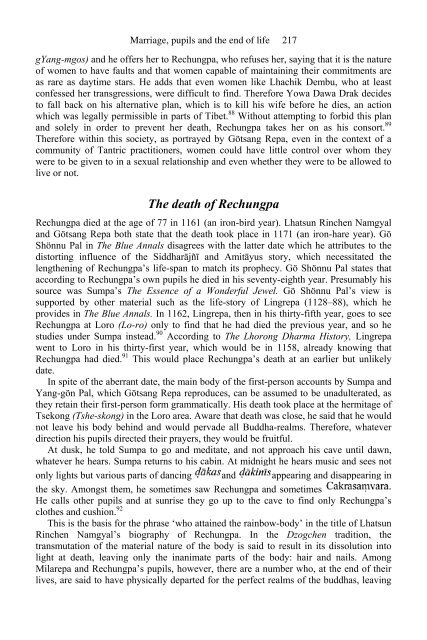The Biographies of Rechungpa: The Evolution of a Tibetan ...
The Biographies of Rechungpa: The Evolution of a Tibetan ...
The Biographies of Rechungpa: The Evolution of a Tibetan ...
You also want an ePaper? Increase the reach of your titles
YUMPU automatically turns print PDFs into web optimized ePapers that Google loves.
Marriage, pupils and the end <strong>of</strong> life 217<br />
gYang-mgos) and he <strong>of</strong>fers her to <strong>Rechungpa</strong>, who refuses her, saying that it is the nature<br />
<strong>of</strong> women to have faults and that women capable <strong>of</strong> maintaining their commitments are<br />
as rare as daytime stars. He adds that even women like Lhachik Dembu, who at least<br />
confessed her transgressions, were difficult to find. <strong>The</strong>refore Yowa Dawa Drak decides<br />
to fall back on his alternative plan, which is to kill his wife before he dies, an action<br />
which was legally permissible in parts <strong>of</strong> Tibet. 88 Without attempting to forbid this plan<br />
and solely in order to prevent her death, <strong>Rechungpa</strong> takes her on as his consort. 89<br />
<strong>The</strong>refore within this society, as portrayed by Götsang Repa, even in the context <strong>of</strong> a<br />
community <strong>of</strong> Tantric practitioners, women could have little control over whom they<br />
were to be given to in a sexual relationship and even whether they were to be allowed to<br />
live or not.<br />
<strong>The</strong> death <strong>of</strong> <strong>Rechungpa</strong><br />
<strong>Rechungpa</strong> died at the age <strong>of</strong> 77 in 1161 (an iron-bird year). Lhatsun Rinchen Namgyal<br />
and Götsang Repa both state that the death took place in 1171 (an iron-hare year). Gö<br />
Shönnu Pal in <strong>The</strong> Blue Annals disagrees with the latter date which he attributes to the<br />
distorting influence <strong>of</strong> the Siddharājñī and Amitāyus story, which necessitated the<br />
lengthening <strong>of</strong> <strong>Rechungpa</strong>’s life-span to match its prophecy. Gö Shönnu Pal states that<br />
according to <strong>Rechungpa</strong>’s own pupils he died in his seventy-eighth year. Presumably his<br />
source was Sumpa’s <strong>The</strong> Essence <strong>of</strong> a Wonderful Jewel. Gö Shönnu Pal’s view is<br />
supported by other material such as the life-story <strong>of</strong> Lingrepa (1128–88), which he<br />
provides in <strong>The</strong> Blue Annals. In 1162, Lingrepa, then in his thirty-fifth year, goes to see<br />
<strong>Rechungpa</strong> at Loro (Lo-ro) only to find that he had died the previous year, and so he<br />
studies under Sumpa instead. 90 According to <strong>The</strong> Lhorong Dharma History, Lingrepa<br />
went to Loro in his thirty-first year, which would be in 1158, already knowing that<br />
<strong>Rechungpa</strong> had died. 91 This would place <strong>Rechungpa</strong>’s death at an earlier but unlikely<br />
date.<br />
In spite <strong>of</strong> the aberrant date, the main body <strong>of</strong> the first-person accounts by Sumpa and<br />
Yang-gön Pal, which Götsang Repa reproduces, can be assumed to be unadulterated, as<br />
they retain their first-person form grammatically. His death took place at the hermitage <strong>of</strong><br />
Tsekong (Tshe-skong) in the Loro area. Aware that death was close, he said that he would<br />
not leave his body behind and would pervade all Buddha-realms. <strong>The</strong>refore, whatever<br />
direction his pupils directed their prayers, they would be fruitful.<br />
At dusk, he told Sumpa to go and meditate, and not approach his cave until dawn,<br />
whatever he hears. Sumpa returns to his cabin. At midnight he hears music and sees not<br />
only lights but various parts <strong>of</strong> dancing and appearing and disappearing in<br />
the sky. Amongst them, he sometimes saw <strong>Rechungpa</strong> and sometimes<br />
He calls other pupils and at sunrise they go up to the cave to find only <strong>Rechungpa</strong>’s<br />
clothes and cushion. 92<br />
This is the basis for the phrase ‘who attained the rainbow-body’ in the title <strong>of</strong> Lhatsun<br />
Rinchen Namgyal’s biography <strong>of</strong> <strong>Rechungpa</strong>. In the Dzogchen tradition, the<br />
transmutation <strong>of</strong> the material nature <strong>of</strong> the body is said to result in its dissolution into<br />
light at death, leaving only the inanimate parts <strong>of</strong> the body: hair and nails. Among<br />
Milarepa and <strong>Rechungpa</strong>’s pupils, however, there are a number who, at the end <strong>of</strong> their<br />
lives, are said to have physically departed for the perfect realms <strong>of</strong> the buddhas, leaving











